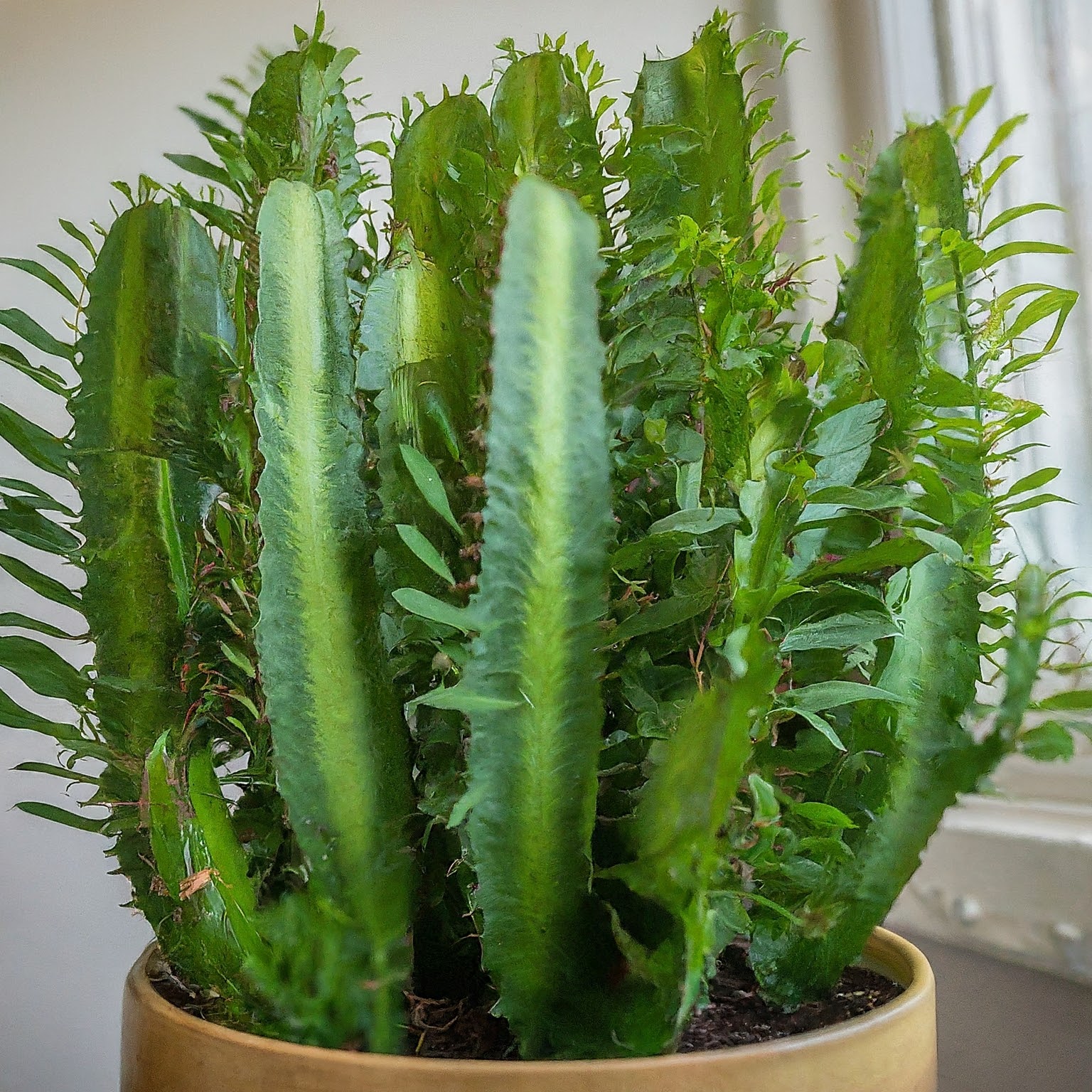Welcome to the ultimate guide on how to grow and care for the African milk tree!
Whether you’re a seasoned gardener or a complete newbie, this guide will help you understand everything you need to know about this fascinating and resilient plant.
Jump to a section:
African Milk Tree
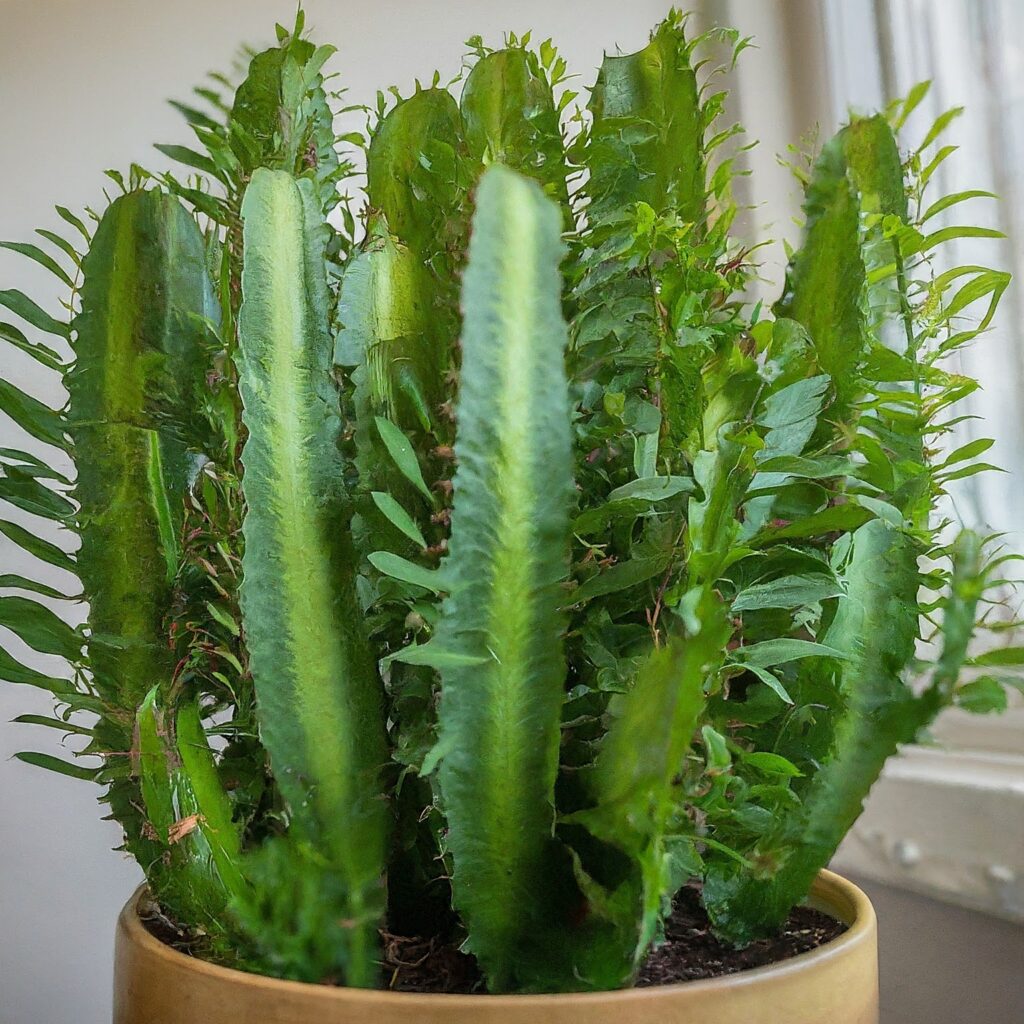
The African milk tree, also known by its scientific name Euphorbia trigona, is a striking and hardy succulent that hails from Central Africa.
Known for its tall, spiky stems and vibrant green color, the African milk tree is a popular choice for both indoor and outdoor gardens. Its unique appearance and relatively low maintenance needs make it an excellent option for beginner gardeners looking to add a touch of exotic flair to their plant collection.
Features and Characteristics
Native to Central Africa, the African milk tree features distinct, upright stems that can grow up to 8 feet tall in ideal conditions.
The stems are typically three-sided, with small, spiny ridges running along each edge. These ridges are adorned with tiny leaves that add to the plant’s visual interest.
One of the most captivating features of the African milk tree is its milky sap, which gives the plant its name. However, be cautious, as this sap is toxic if ingested and may cause irritation if it comes in contact with your skin.
This plant thrives in the warm, arid climates of countries like Namibia and Angola.
In its natural habitat, it often forms dense thickets and serves as a protective barrier due to its spiny structure. Over the years, this resilient plant has gained popularity worldwide for its unique aesthetic and ease of care, making it a favorite among gardeners everywhere.
The African milk tree’s cultural significance extends beyond its ornamental value.
In many African cultures, it is considered a symbol of resilience and protection, often planted around homes and gardens as a natural security measure.
Plus, its hardy nature and ability to thrive in challenging environments have made it a symbol of endurance and adaptability, embodying the spirit of survival in harsh climates.
This cultural heritage adds an extra layer of appreciation for those who choose to cultivate this remarkable plant in their homes and gardens.
Check out this Reddit post about African milk tree:
Here’s a table with essential information about the African milk tree.
| Fact | Details |
| Scientific Name | Euphorbia trigona |
| Common Names | African Milk Tree, Cathedral Cactus, Friendship Cactus |
| Family | Euphorbiaceae |
| Native Region | Central Africa (Namibia, Angola) |
| Height | Up to 8 feet (2.4 meters) |
| Growth Habit | Upright, spiky stems with three sides |
| Leaves | Small, oval leaves growing along the ridges of the stems |
| Sap | Milky, white sap that is toxic and can cause skin irritation |
| Sunlight Requirements | Bright, indirect light; tolerates some direct sunlight |
| Watering Needs | Drought-tolerant; water thoroughly and allow soil to dry out between waterings |
| Soil Requirements | Well-draining cactus or succulent mix |
| Temperature Range | 65°F to 80°F (18°C to 27°C); avoid temperatures below 50°F (10°C) |
| Humidity | Prefers low to moderate humidity |
| Fertilization | Feed with a balanced, diluted fertilizer once a month during the growing season. |
| Propagation Methods | Stem cuttings |
| Pests | Aphids, mealybugs, spider mites |
| Common Problems | Overwatering, root rot, sunburn |
| Flowering | Rarely flowers in cultivation; small, inconspicuous flowers |
| Toxicity | Toxic to pets and humans if ingested; sap can cause skin irritation |
| Cultural Significance | Symbol of resilience and protection in many African cultures |
| Cost | Typically ranges from $20 to $50 for small to medium-sized plants |
| USDA Hardiness Zone | 9 – 11 |
How to Grow and Care for African Milk Tree
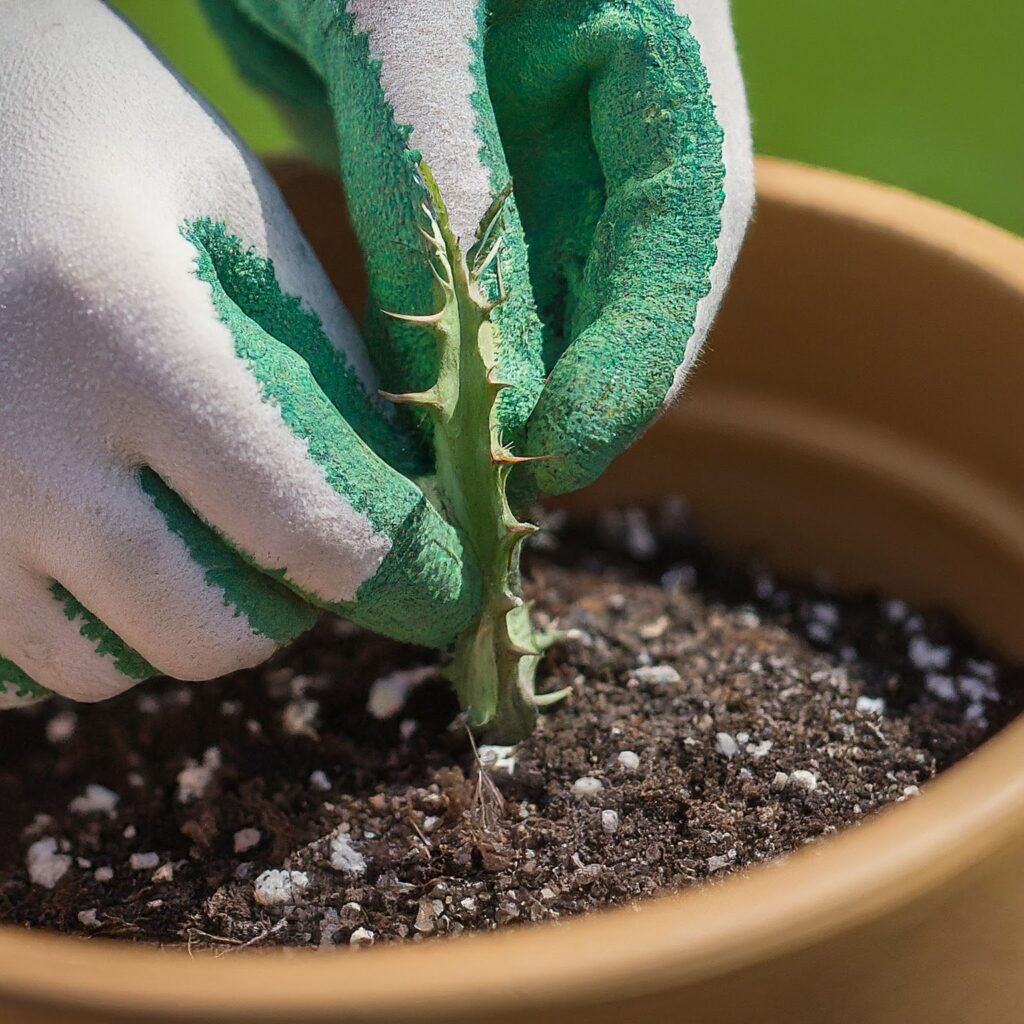
Now that you know the background and facts about the African milk tree, let’s discuss how to grow and care for this succulent.
Choosing the Right Location
When it comes to African milk tree care, location is key.
This plant loves sunlight, so choose a spot that receives plenty of bright, indirect light.
If you’re growing it indoors, a south or west-facing window is ideal.
Outdoor gardeners should place it in a spot where it can bask in the morning sun and enjoy some afternoon shade to avoid scorching.
Planting the African Milk Tree
First things first, select a well-draining potting mix, ideally one designed for cacti and succulents. This ensures that excess water doesn’t linger around the roots, which can lead to rot.
- Pot Selection: Choose a pot that’s slightly larger than the root ball of your African milk tree. Also, ensure the pot has drainage holes to avoid overwatering.
- Soil Preparation: Use a cactus or succulent mix, which is specifically designed to be fast-draining. If you can’t find a succulent mix, you can make your own by mixing regular potting soil with sand or perlite.
- Planting: Place a layer of gravel or small stones at the bottom of the pot to further improve drainage. Fill the pot with soil, leaving enough space to place the plant. Gently position the African milk tree in the center and fill in around the roots with more soil, pressing down lightly to secure the plant.
Watering
One of the biggest mistakes new gardeners make is overwatering.
The African milk tree is drought-tolerant, so it prefers its soil to dry out between waterings.
During the growing season (spring and summer), water your plant once every two weeks. In the dormant period (fall and winter), cut back to once a month.
You can prevent root rot by checking the soil moisture before watering!
How?
Stick your finger about an inch deep into the soil. If it feels dry to the touch, it’s time for a thorough watering. Water until water drains freely out of the drainage holes at the bottom of the pot.
Avoid getting water on the stems and leaves as this can lead to fungal problems. Think of it like giving your African milk tree a nice drink, but not a shower!
Temperature and Humidity
The African milk tree thrives in warm temperatures between 65°F and 80°F (18°C to 27°C).
While it can tolerate lower temperatures, avoid exposing it to anything below 50°F (10°C). Consider bringing them inside during winter if you live in a cooler climate to avoid potential damage from frost.
While the African milk tree can tolerate a range of humidity levels, it generally prefers drier conditions. Avoid placing it in overly humid areas, such as bathrooms or kitchens, where it might be exposed to excessive moisture.
Fertilizing
During the growing season, feed your African milk tree with a balanced, water-soluble fertilizer with equal parts nitrogen, phosphorus, and potassium (e.g., 10-10-10) and diluted to half-strength.
Fertilize once a month from spring through early fall to promote healthy growth. Avoid fertilizing during the winter months when the plant is dormant.
Don’t forget to water the plant thoroughly before applying fertilizer to prevent root burn. Pour the diluted fertilizer around the base of the plant, avoiding contact with the stems and leaves.
Feeling adventurous? Learn how to create nitrogen fertilizer for your Afircan milk tree.
Pruning and Maintenance
Pruning your African milk tree helps maintain its shape and encourages new growth. Regular pruning also helps prevent the plant from becoming top-heavy and falling over.
- Tools and Safety: Use a pair of sharp, sterilized pruning shears. Wear gloves and protective clothing to avoid contact with the plant’s sap.
- Pruning Technique: Identify any stems that are too long, damaged, or crossing over each other. Make clean cuts at an angle just above a leaf node or stem junction.
- Aftercare: Allow the pruned sections to callus over for a few days before resuming normal watering. This helps prevent rot and infection.
How to Propagate African Milk Tree
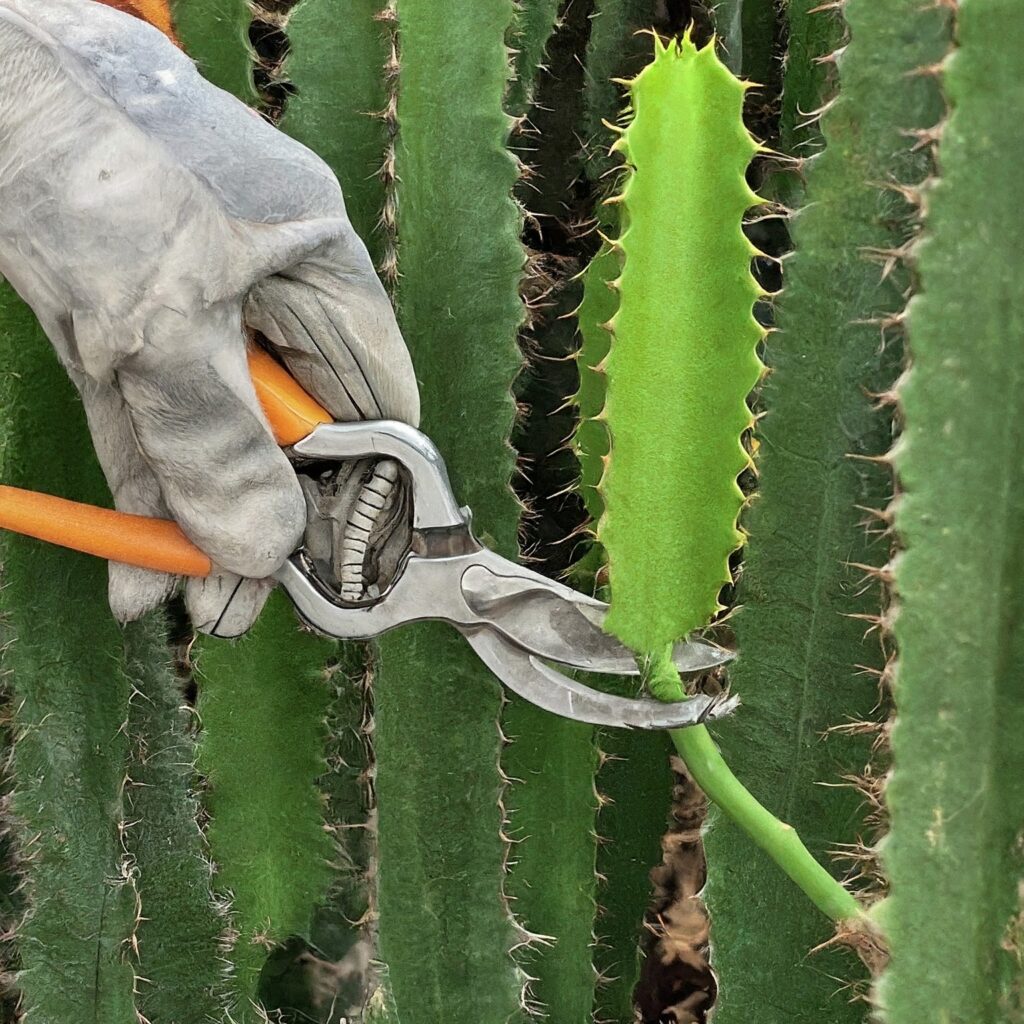
Propagation is an exciting way to expand your collection of African milk tree plants.
Best Time to Propagate
The best time for African milk tree propagation is during the spring and early summer when the plant is actively growing. This gives your cuttings the best chance to root and establish themselves.
Steps for Propagation
- Prepare Your Tools: Ensure you have clean, sharp shears, gloves, and a well-draining potting mix ready.
- Take a Cutting: Select a healthy stem with no signs of disease or damage. The cutting should be at least 4-6 inches long to ensure enough stored energy for root development.
- Allow to Callus: Place the cutting in a dry, shaded area for a few days to allow the cut end to callus over. This helps prevent rot when planted.
- Plant the Cutting: Once callused, plant the cutting in a pot filled with well-draining soil. Insert the cut end of the stem about an inch deep into the potting soil.
- Water Sparingly: Lightly water the soil and place the pot in a bright, indirect light location. Water the soil enough to dampen it slightly, but avoid leaving it saturated.
- Wait for Roots: In a few weeks, you should see new growth, indicating that roots have formed. At this point, you can begin normal care routines. Avoid direct sunlight, which can stress the cutting before it establishes roots.
Check out this video on how to propagate the African milk tree:
How to Tackle the Common Problems With African Milk Tree
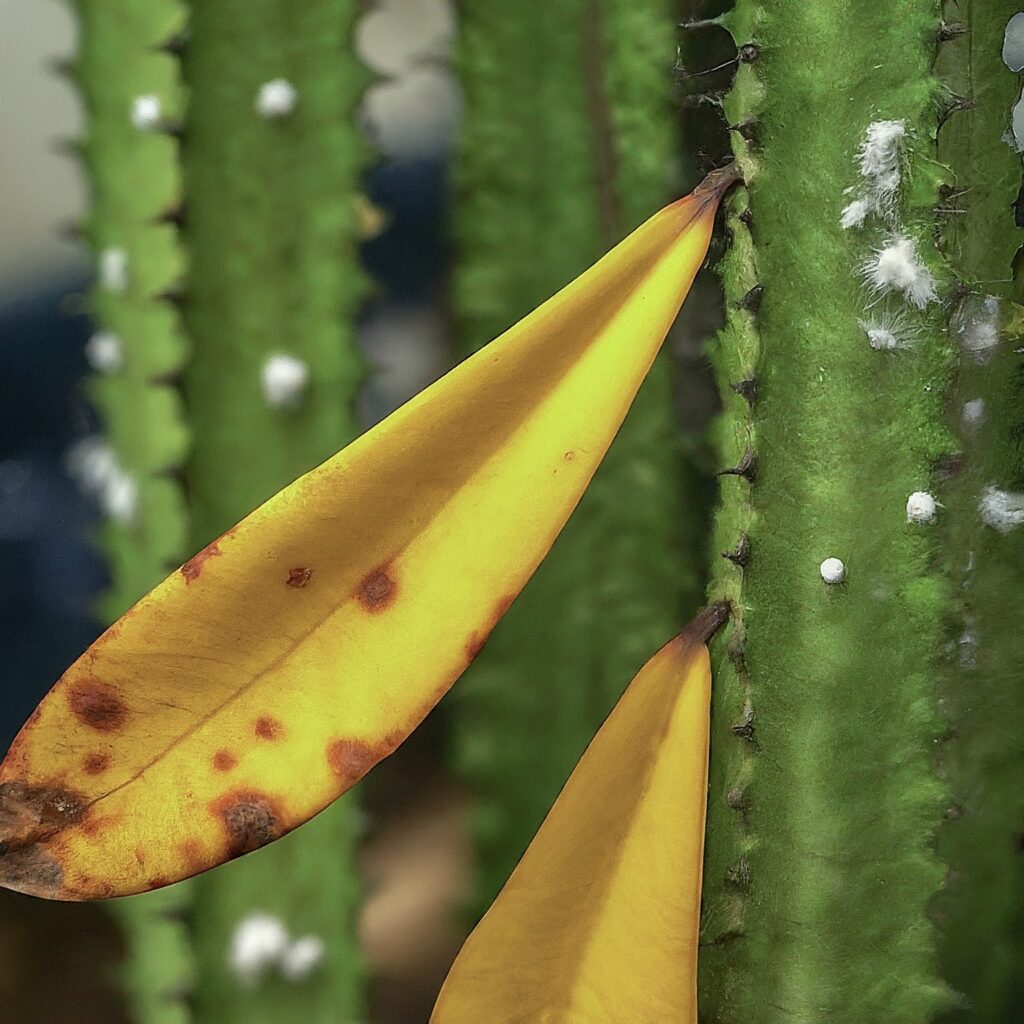
Even the hardiest plants can encounter issues.
Here’s how to address some common African milk tree problems that you might come across:
Overwatering
Overwatering is the most common problem. If your plant’s leaves turn yellow and the stems feel mushy, it’s likely suffering from root rot. To remedy this, remove the African milk tree from its pot, trim away any rotten roots, and repot in fresh, well-draining soil.
- Signs of Overwatering: Look for yellowing leaves, mushy stems, and a foul odor emanating from the soil. These are signs of root rot.
- Immediate Action: To assess root health, carefully remove the plant from its pot and check the root system. Healthy roots should be firm to the touch and appear white or light tan in color. Trim away any black, mushy roots with sterilized shears.
- Repotting: Repot the plant in fresh, well-draining soil and a clean pot. Allow the plant to dry out for a few days before resuming a light watering schedule.
Pests
Aphids, mealybugs, and spider mites are common pests that can affect your African milk tree. As such, you should know how to identify and manage the common pests.
- Identifying Pests: Regularly inspect your plant for signs of pests. Aphids appear as small green or black insects, mealybugs look like white, cottony masses, and spider mites leave fine webbing on the plant.
- Treatment Options: For a mild infestation, you can use DIY pest control methods like using a cotton swab dipped in rubbing alcohol to remove the pests. For larger infestations, apply insecticidal soap according to the manufacturer’s instructions.
- Preventative Measures: Keep your plant healthy and stress-free to reduce the likelihood of pest infestations. Quarantine new plants for a few weeks before adding them to your collection. This can help prevent pest spread.
Sunburn
Too much direct sunlight can cause the plant’s leaves to burn, turning them brown and crispy. If this happens, move your plant to a location with less intense light and trim away the damaged leaves.
Growth Issues
If your plant is growing too tall and top-heavy, it may need more support. In such a situation, it is a good idea to stake the plant with a bamboo stick or similar support to keep it upright.
Regular pruning can also help manage its height. Plus, rotate the plant regularly to ensure even light exposure on all sides, which promotes balanced growth.
How to Grow African Milk Tree from Seeds
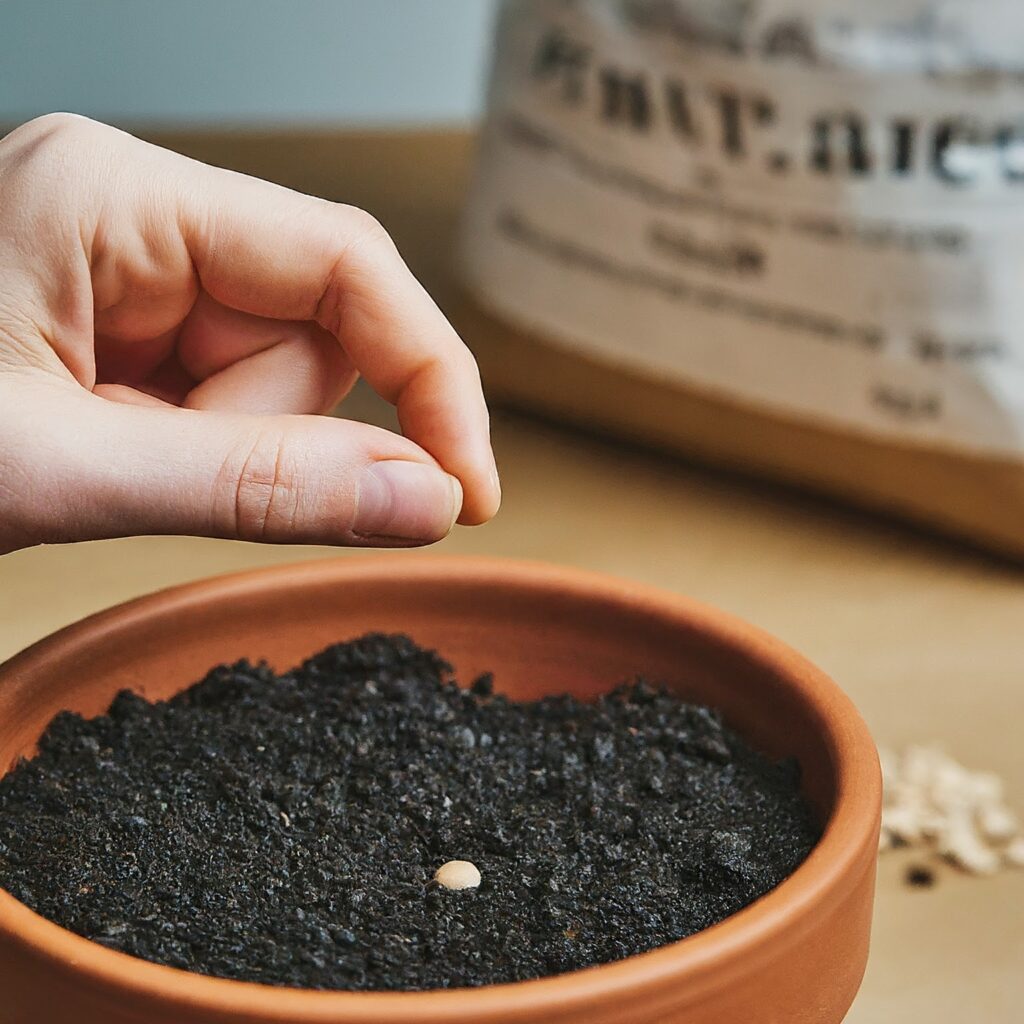
Growing an African milk tree from seeds is a rewarding but slow process.
Here’s how to do it:
- Acquire Fresh Seeds: Obtain seeds from a reputable source.
- Prepare the Soil: Use a well-draining seed starting mix designed for cacti and succulents.
- Sow the Seeds: Place the seeds on the soil surface and lightly cover them with a thin layer of soil.
- Water Sparingly: Mist the soil lightly to avoid washing away the seeds.
- Provide Light: Place the seed tray in a warm, bright location with indirect light.
- Patience is Key: Germination can take several weeks to months, so be patient.
African Milk Tree Types
While Euphorbia trigona is the most common African milk tree variety, there are two other types you might encounter:
- Euphorbia trigona ‘Rubra’: Also known as the “Red African Milk Tree,” this variety features stems and leaves that range from a deep burgundy to a vibrant red. The color becomes more intense with increased sunlight exposure, making it a striking addition to any plant collection.
- Euphorbia trigona ‘Royal Red’: This type boasts even deeper red hues than the ‘Rubra’ variety. The intense coloration and robust growth make it a popular choice among collectors looking for a bold statement plant.
African Milk Tree Benefits
The African milk tree isn’t just a pretty face; it offers several benefits:
- Low Maintenance: The African milk tree is ideal for those who might not have the greenest of thumbs. Its drought tolerance and minimal watering needs make it an easy-care plant that can thrive with little attention.
- Air Purification: Like many houseplants, the African milk tree helps filter and purify indoor air, removing harmful toxins and improving overall air quality. This makes it a great addition to your home or office environment.
- Aesthetic Appeal: The unique, architectural shape of the African milk tree adds a touch of exotic elegance to any space. Its tall, spiky stems and vibrant color make it a standout feature in both indoor and outdoor gardens.
Conclusion
Growing and caring for an African milk tree can be a deeply rewarding experience. With its unique appearance and easy-going nature, it’s an excellent choice for gardeners of all levels. Follow the tips and advice in this guide and you’ll be well on your way to growing a thriving, healthy African milk tree in your own space.
FAQ
Why is it called an African milk tree?
The name comes from the plant’s origin in Africa and the milky sap it produces. This sap is a common characteristic of many plants in the Euphorbia family.
Is an African milk tree a cactus?
No, despite its appearance, the African milk tree is a succulent, not a cactus. It belongs to the Euphorbia family, which includes many other types of succulents.
Do African milk trees like sun?
Yes, they thrive in bright, indirect sunlight. However, too much direct sun can cause sunburn, especially if the plant is not acclimated to intense light.
How much does an African milk tree cost?
The cost can vary depending on size and location, but typically ranges from $20 to $50 for a small to medium-sized plant. Larger, more mature plants can cost significantly more, especially rare varieties like ‘Rubra’ or ‘Royal Red’.
